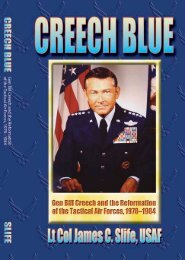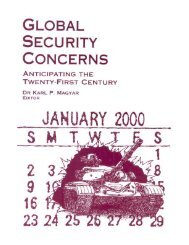Expendable Remotely Piloted Vehicles for Strategic Offensive ...
Expendable Remotely Piloted Vehicles for Strategic Offensive ...
Expendable Remotely Piloted Vehicles for Strategic Offensive ...
You also want an ePaper? Increase the reach of your titles
YUMPU automatically turns print PDFs into web optimized ePapers that Google loves.
tions. One specially modified drone was reported to have drawn 10 or 11SAMs be<strong>for</strong>e being shot down. 53 The top per<strong>for</strong>ming drone flew an incredible68 sorties, averaging twelve targets per mission. 54 In the latter part ofthe war, survival rates of UAVs exceeded 90 percent. While difficult tomake a direct comparison, there is a definite contrast with manned aircraftstatistics: “In that same war America lost more than 2,500 mannedaircraft, about 5,000 of her airmen were killed, and nearly 90 percent ofall US servicemen taken prisoner were pilots and crewmen.” 55At the same time that the United States was attempting to understandand appreciate unmanned aircraft, the Israeli Defense Force effectivelyused UAVs over battlefields in the October 1973 Yom Kippur War andagain in the 1982 Bekáa Valley air battle. The Israelis innovatively employedUMA to “fingerprint” SAM radars, simulate full-size decoy attackaircraft, per<strong>for</strong>m electronic countermeasures, and conduct real-time intelligencegathering. 56 Most noteworthy was their effective use as decoys.By sending in UAVs to spearhead an attack, virtually all enemy SAMs wereexpended at once. This revealed SAM locations, and Israeli suppression ofenemy air defenses sorties were thus able to follow and knock out missiledefenses while the enemy was reloading. It was reported that one RPVsafely returned <strong>for</strong> recovery after surviving attacks by 32 SAMs.Despite the successful US missions conducted over Southeast Asia,there were difficulties associated with UAVs. Initially, novice operatorsand maintenance crews were only able to generate three to four sorties perairframe. By the end of the war, they managed to increase this number to25. During this learning experience, any UMA loss still caused repercussions.This was because military leaders treated it in the same manner asthe loss of a manned aircraft. In 1979 US Air Force (USAF) Col William E.Krebs authored a paper titled, “Did We Err in the Development of RPVs(RPVs)?” One of his findings was that during the Vietnam War, “an RPVloss was treated like an aircraft loss—fleets were grounded, boards<strong>for</strong>med, data generated, commanders fired, and worst of all, prejudiceagainst RPVs vis-à-vis manned aircraft developed.” 57The time frame of US involvement in Southeast Asia was a period of extensiveUAV research and testing. The evolutionary program <strong>for</strong> TeledyneRyan’s Firebee consisted of 26 configurations, 903 airframes, and 1,100major modifications. 58 RPV test demonstrations extended well beyond reconnaissanceinto attack roles; however, it was the Navy, not the AirForce, leading this ef<strong>for</strong>t. According to Jane’s <strong>Remotely</strong> <strong>Piloted</strong> <strong>Vehicles</strong>:“The US Navy has even evaluated RPV interceptors in simulated air combatagainst a McDonnell Douglas F-4 Phantom II flown by a highly experiencedaircrew. The results were thought-provoking. All the Sparrow andSidewinder missiles launched from the Phantom missed the RPV, but thelatter maneuvered itself several times into positions from which it couldhave brought down the Phantom had it been armed.” 59In light of tests and operational applications in Southeast Asia, lack ofadvocacy and proper oversight have restrained any motivation in the18






